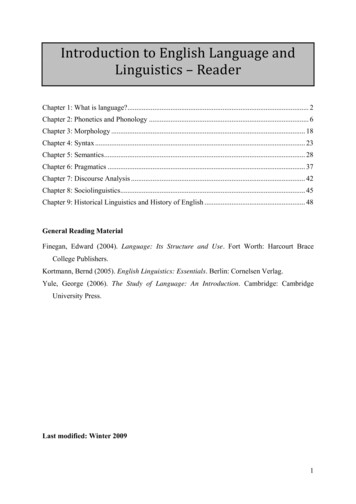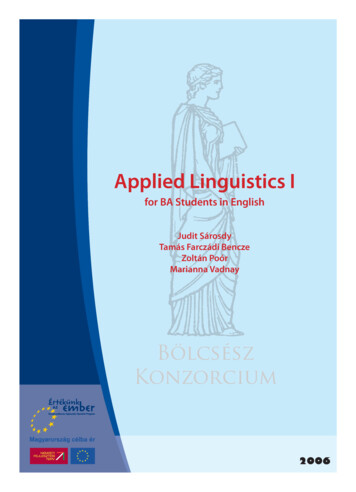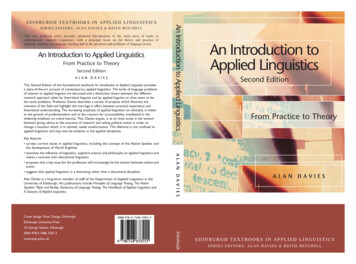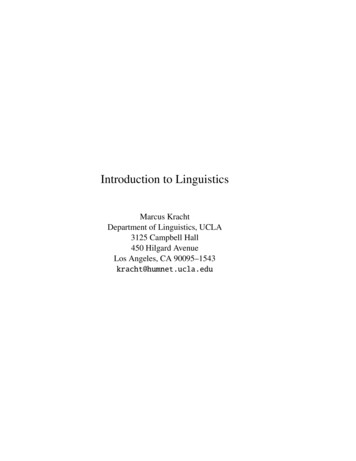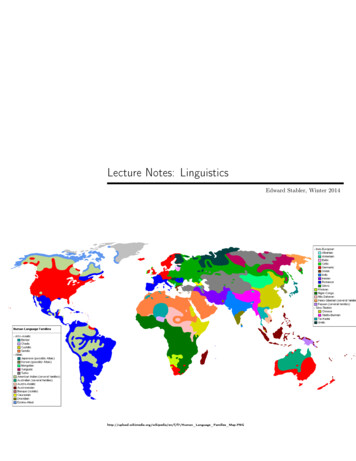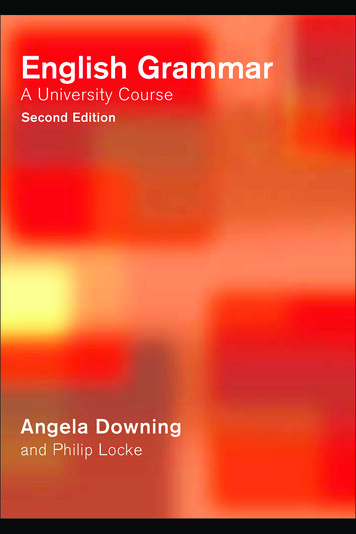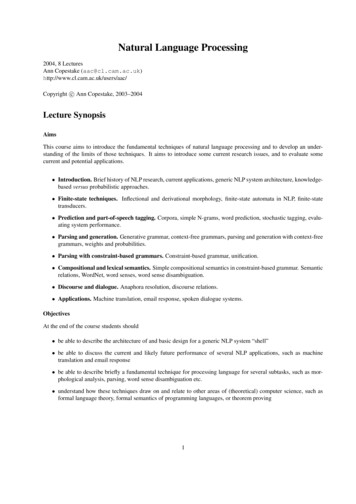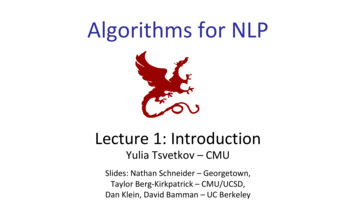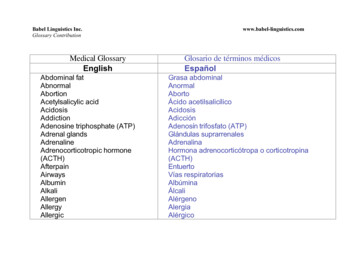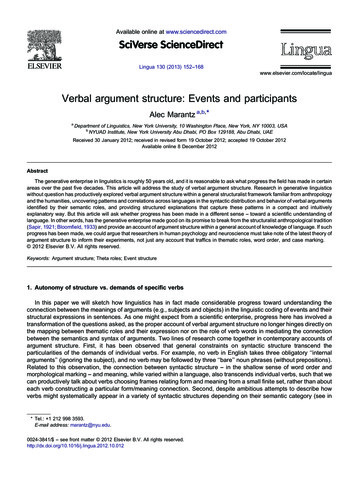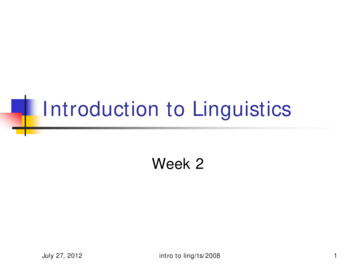
Transcription
Introduction to LinguisticsWeek 2July 27, 2012intro to ling/ts/20081
Language? Linguistics?July 27, 2012intro to ling/ts/20082
Language a system of conventional spoken or written symbolsby means of which human beings, as members of asocial group and participants in its culture,communicate (Encyclopedia Britannica)expression of ideas by means of speech-soundscombined into words. Words are combined intosentences, this combination answering to that ofideas into thoughts (Henry Sweet, an Englishphonetician and language scholar)July 27, 2012intro to ling/ts/20083
a system of arbitrary vocal symbols bymeans of which a social groupcooperates (The U.S. linguists BernardBloch and George L. Trager)July 27, 2012intro to ling/ts/20084
Language as a Means mationencodesJuly 27, 2012decodesintro to ling/ts/20085
Difference betweenLanguages Languages can differ in: the fundamental elementsor the rules of combinationThe units and rules can be different for all of themodules of language: sounds, words, andsentencesBut all languages are equally complex, they allhave units and rules.Dialects differ in the same way -- units and rules.Languages change in the same way -- units andrules.Children learn languages in the same way -- unitsand rules.Any child can learn any human language if exposedto it.July 27, 2012intro to ling/ts/20086
Linguistics the scientific study of language that answersthe questions: what is language? how is itrepresented in the mind?a social science that shares common groundwith other social sciences such as psychology,anthropology, sociology and archaeology;may also influence other disciplines such asEnglish, communication studies, computerscience etcJuly 27, 2012intro to ling/ts/20087
History Comes from the Latin word lingua whichmeans languageFerdinand de Saussure (the father of modernlinguistics) in his book Cours de linguistiquegenerale proposed the terms langage, langueand parole.langage : language in generallangue : a particular languageparole : the language of an individualJuly 27, 2012intro to ling/ts/20088
Linguist is someone who engages in studyinglinguisticsfocuses on describing and explaininglanguage; not concerned with the prescriptiverules of the languageis not an interpreter; not required to knowmany languagesgoal: to discover the universals concerninglanguageJuly 27, 2012intro to ling/ts/20089
The Field of Linguistics synchronic vs diachronic linguisticstheoretical vs applied linguisticsmicrolinguistics vs macrolinguisticsJuly 27, 2012intro to ling/ts/200810
yneurolinguisticscomputational linguisticshistorical linguisticsdiscourse analysisJuly 27, 2012intro to ling/ts/200811
Phonetics the study of the production and perception ofspeech soundsis concerned with the sounds of language,how these sounds are articulated and howthe hearer perceives themis related to the science of acoustics in that ituses much the same techniques in theanalysis of sound that acoustics doesJuly 27, 2012intro to ling/ts/200812
Phonology the study of the sound patterns of languageis concerned with how sounds are organizedin a languageexamines what occurs to speech soundswhen they are combined to form a word andhow these speech sounds interact with eachotherendeavors to explain what these phonologicalprocesses are in terms of formal rulesJuly 27, 2012intro to ling/ts/200813
Morphology the study of word formation andstructurestudies how words are put togetherfrom their smaller parts and the rulesgoverning this processJuly 27, 2012intro to ling/ts/200814
Syntax the study of sentence structureattempts to describe what isgrammatical in a particular language interm of rulesthese rules detail an underlyingstructure and a transformationalprocessJuly 27, 2012intro to ling/ts/200815
Semantics the study of meaningis concerned with describing how werepresent the meaning of a word in ourmind and how we use thisrepresentation in constructingsentencesis based largely on the study of logic inphilosophyJuly 27, 2012intro to ling/ts/200816
Language Acquisition examines how children learn to speak andhow adults learn a second languageis very important because it gives us insightin the underlying processes of languagesuggests that all languages operate withinthe same framework and the understandingof this framework would contribute greatly tothe understanding of what language is.July 27, 2012intro to ling/ts/200817
Others istorical LinguisticsAnthropological LinguisticsPragmaticsetcJuly 27, 2012intro to ling/ts/200818
Introduction to LinguisticsWeek 3September 20, 2007intro to ling/ts/20071
The Languages of theWorldSeptember 20, 2007intro to ling/ts/20072
The Origins of Language Homo Loquens- cave drawings- gestures- speech? Human language emerged 30,000 years ago written language: 20,000 years goSeptember 20, 2007intro to ling/ts/20073
Language BarrierJavaneseEnglishSeptember 20, 2007intro to ling/ts/20074
Pidgin and Creole Pidgin a system of communication which has grownup among people who do not share a commonlanguage, but who want to talk to each other, fortrading or other reasons Creole a pidgin language which has become themother tongue of a communitySeptember 20, 2007intro to ling/ts/20075
Pidgin Called as makeshift, marginal, or mixedlanguage Has limited vocabulary, a reduced grammaticalstructure, narrower range of functions Does not last very long, sometimes for only afew years, rarely for more than a century e.g. French used in Vietnam disappeared whenthe French leftSeptember 20, 2007intro to ling/ts/20076
Creole Comes from Portuguese crioulo a person of European descent who had beenborn and brought up in a colonial territory; then applied to other people who were native tothese areas, and then to the kind of languagethey spoke More advanced patterns of language because ofthe interaction with the language existed beforeSeptember 20, 2007intro to ling/ts/20077
Families of Languages Europe: Indo-European, Uralic, Maltese, Turkic South Asia: Indo-Iranian, Dravidian, Austroasiatic, SinoTibetan, Tai North Asia: Uralic, Altaic (Turkic, Mongolian, ManchuTungus), Paleo-Siberian Southwest Asia: Indo-Iranian, Caucasian, SemiticSeptember 20, 2007intro to ling/ts/20078
East Asia: Altaic, Korean, Japanese, Sino-Tibetan(Chinese, Tibeto-Burman), Tai & Miao-Yao Southeast Asia: Austroasiatic, Tai & Sino-Tibetan,Andamanese, Austronesian Non Austronesian languages of Oceania: Papuan,Australian Aboriginal Africa: Afro-Asiatic/Hamito-Semitic, Nilo-Saharan,Niger-Congo, KhoisanSeptember 20, 2007intro to ling/ts/20079
Americas: Eskimo-Aleut, Athabascan,Algonkian, Macro-Siouan, Hokan,Penutian, Aztec-Tanoan, Oto-Manguean,South American IndianSeptember 20, 2007intro to ling/ts/200710
Language Isolates Languages that are not known to berelated to any other living languagee.g. Basque (northern Spain & southwestern France); Ainu (northern Japan);Burushaski (Pakistan), Taraskan(California)September 20, 2007intro to ling/ts/200711
Top 20 Languages(based on the number of speakers)Mother-tongue eptember 20, 200711. French12. Panjabi13. Javanese14. Bihari15. Italian16. Korean17. Telugu18. Tamil19. Marathi20. VietnameseOfficial Language ntro to iTurkish12
Where is English?Indo European languagesGermanicItalicGerman, Dutch, English, etcCelticBalticAlbanianArmenianSlavicIndo IranianHellenicSeptember 20, 2007intro to ling/ts/200713
History of English Languagebegins with the migration of the Jutes, Angles,and Saxons from Germany and Denmark toBritain in the 5th – 6th centuryOld Englishbegins during the Norman Conquest in 1066Middle Englishstarted at the beginning of the 15th centuryModern EnglishSeptember 20, 2007intro to ling/ts/200714
Old English Also called Anglo-Saxon Language spoken and written in Englandbefore 1100; it is the ancestor of Middleand Modern English 4 dialects: Northumbrian, Mercian,Kentish, West Saxon Great period of literary activity: during thereign of King Alfred in 9th centurySeptember 20, 2007intro to ling/ts/200715
Has 3 genders: masculine, feminine,neutrale.g. Old English helpan help, healp, hulpon, holpenSeptember 20, 2007intro to ling/ts/200716
Middle English Language spoken and written in Englandfrom about 1100-1500a. 1100-1250: early Middle Englishb. 1250-1400: central Middle Englishc. 1400-1500: late Middle English 3 dialects: Southern, Midland, NorthernSeptember 20, 2007intro to ling/ts/200717
Modern English In 16th century it was the mother tongue of onlya few million people living in England By the late 20th century, it is the native languageof more than 350 million people The most widely taught foreign language and isalso the most widely used second language In the entire world, one person in seven speaksEnglish as either a primary or secondarylanguageSeptember 20, 2007intro to ling/ts/200718
English Language Imperialism Involves the transfer of a dominantlanguage to other people to demonstratepower In America, Australia, New Zealand new varieties of English weredeveloped by native speakers comingfrom the British isles; colonial speech, aninferior form of EnglishSeptember 20, 2007intro to ling/ts/200719
In West Africa pidgins: Portuguese Africanlanguages English creoles Now?September 20, 2007intro to ling/ts/200720
Introduction to LinguisticsWeek 4July 27, 2012intro2ling/ts/20081
THEORIESin LINGUISTICSJuly 27, 2012intro2ling/ts/20082
Ferdinand de Saussure(1857–1913)July 27, 2012intro2ling/ts/20083
Ferdinand de Saussure The father of modern linguisticsSaussure's most influential work, Coursein General Linguistics (Cours delinguistique générale), was publishedposthumously in 1916 by former studentsCharles Bally and Albert Sechehaye on thebasis of notes taken from Saussure'slectures at the University of Geneva.July 27, 2012intro2ling/ts/20084
Theory of SaussureLanguageSignsLinguisticsLangageThe signifierSynchronicLangueThe signifiedDiachronicParoleJuly 27, 2012intro2ling/ts/20085
Langue and parolein his book Cours de linguistiquegenerale, Saussure proposed the termslangage, langue and parole.langage: language in generallangue : a particular languageparole : the language of an individualJuly 27, 2012intro2ling/ts/20086
Diachronic vs. synchronic view oflinguisticsJuly 27, 2012intro2ling/ts/20087
Diachronic view Diachronic linguistics views the historicaldevelopment of a language.We can go back and forth in time,watching the language with all its featureschange.E.g. the change in sound system ofEnglish from old English to modern EnglishJuly 27, 2012intro2ling/ts/20088
Synchronic view Synchronic linguistics views a particularstate of a language at some given point intime.This could mean Modern English of thepresent day, or the systematic analysis ofthe system of Shakespeare's English.E.g. the modern system of modern EnglishJuly 27, 2012intro2ling/ts/20089
structuralism Modern linguistics, following Ferdinand deSaussure, is primarily interested in thesynchronic point of view.Saussure postulated the priority of synchrony: noknowledge of the historical development of alanguage is necessary to examine its presentsystem.He arrived at this radical viewpoint due to hisconviction that linguistic research mustconcentrate on the structure of language.Later, the whole paradigm was hence calledstructuralismJuly 27, 2012intro2ling/ts/200810
Theory of signs (semiotics)In linguistics, the sign has ‘two faces’which cannot be separated ‘signified’ thing meant ‘signifiant’ or ‘signifier’ theaccoustic imageJuly 27, 2012intro2ling/ts/200811
Descriptive vs prescriptive Prescriptive- the 19th century grammar wasprescriptive- how the laguage shoud be Descriptive- acc. to Saussure, linguists’ job is todescribe, not to prescribeJuly 27, 2012intro2ling/ts/200812
Paradigmatic vs. syntagmatic Paradigmaticany link in chain of speech willsuggest any other language units tous, because the units eitherresemble or differ from each other inform and meaning.e.g. the word ‘teaching’July 27, 2012intro2ling/ts/200813
Remindus of other words that have–ing ending: working, eating,talking, etc Other compounds of teach: teacher,taught, teaches Other words with similar meaningand form: tutor, mentor, lecturer Words different in both form andmeaning: chalk, whiteboardJuly 27, 2012intro2ling/ts/200814
syntagmaticSyntagmatic relation holds betweenthe successive members of a givenchaine.g:If I have moneyI will buy a carOne of the books is July 27, 2012intro2ling/ts/200815
Noam ChomskyJuly 27, 2012intro2ling/ts/200816
Noam Chomsky inthe past received various deaththreats because of his criticisms ofU.S foreign policy. statedthat he continues to reside inthe United States because hebelieves it remains the "greatestcountry in the world,"July 27, 2012intro2ling/ts/200817
Syntactic structures The theory takes utterances (sequences ofwords) to have a syntax which can be(largely) characterized by a formalgrammar; in particular, a Context-freegrammar extended with transformationalrules.A phrase/sentence has its internalstructureJuly 27, 2012intro2ling/ts/200818
Childrenare hypothesized to have aninnate knowledge of the basicgrammatical structure common to allhuman languages (i.e. they assumethat any language which theyencounter is of a certain restrictedkind). Thisinnate knowledge is oftenreferred to as universal grammar.July 27, 2012intro2ling/ts/200819
Generative grammarThe Chomskyan approach towards syntaxis often termed generative grammar Chomskyan syntactic analyses are oftenhighly abstract, and are based heavily oncareful investigation of the borderbetween grammatical and ungrammaticalconstructs in a language. Such grammatical judgments can only bemade accurately by a native speaker, July 27, 2012intro2ling/ts/200820
Introduction to LinguisticsWeek 5September 20, 2007intro to ling/ts/20071
PhoneticsDescription of SoundsSeptember 20, 2007intro to ling/ts/20072
Definition the study of speech sounds and theirphysiological production and acousticqualitiesSeptember 20, 2007intro to ling/ts/20073
Fields articulatory phonetics deals with the configurations of the vocal tract used toproduce speech sounds; studies the physiologicalmechanisms of speech production acoustic phonetics measuring and analyzing the physical properties ofsound waves we produce when we speak auditory phonetics studies speech sounds in terms how we hear them linguistic phonetics the manner of combining sounds so as to makesyllables, words, and sentencesSeptember 20, 2007intro to ling/ts/20074
Units of Representation Feature: subunit of segment, reflects individualaspect of articulatory control produced byarticulation Segment: individual speech sound Syllable: a segment of speech that consists of avowel, with or without one or moreaccompanying consonant sounds immediatelypreceding or followingSeptember 20, 2007intro to ling/ts/20075
Phonetic Transcription IPA (International Phonetic Alphabet) represents each sound of human speechwith a single symbole.g. [ə] ; [θ]Why do we need the IPA?September 20, 2007intro to ling/ts/20076
We need a system for recording speechsounds accurately. English spelling isvery inconsistent. Same sound [i], different letterse.g. see, sea, scene, receive, thief, amoeba,machine Same letters, different soundse.g. sign [s], pleasure [ʒ], resign [z] One sound, multiple letterse.g. lock [k], that [ð], book [ʊ], boast [o], shop [ʃ] One letter, multiple soundse.g. exit [gz], use [ju] Silent letterse.g. know, doubt, though, islandSeptember 20, 2007intro to ling/ts/20077
Sound ClassesBased on the phonetic properties shared: Vowels Consonants GlidesSeptember 20, 2007intro to ling/ts/20078
English ssvoicedApproximantvoicelessvoicedSeptember 20, ltdnfvθðVelarGlottalkgŋszʃʒčǰhʍwrintro to ling/ts/2007lj9
English ed Unrounded Unrounded axæSeptember 20, 2007ʌɑintro to ling/ts/200710
Figure out the differences betweenconsonants and vowels in the followingwords. September 20, 2007take – abovecart – atthink – uglybell – openfeel – eelintro to ling/ts/200711
Major DifferencesConsonantsVowels syllabic non syllabic are produced with are produced with arelatively littlenarrow or completeobstruction in the vocalclosure in the vocaltract (-obstruent)tract ( obstruent) are more sonorous are less sonorous( sonorant)(-sonorant)September 20, 2007intro to ling/ts/200712
Glides Shows properties of both consonants andvowels rapidly articulated vowels vowel-like in articulation pattern/function as consonants Sometimes are called semivowel andsemiconsonante.g. yet; wetSeptember 20, 2007intro to ling/ts/200713
Introduction to LinguisticsWeek 61July 27, 2012intro to ling/ts/2007
Phonology: Sound Arrangement2July 27, 2012intro to ling/ts/2007
Definition 3the sound system of a language; the component of agrammar which includes the inventory of sounds(phonetic and phonemic units) and rules for theircombination and pronunciation; the study of thesound systems of all languagesJuly 27, 2012intro to ling/ts/2007
Scope 4Phonetics -- What are the sounds? How are theymade in the mouth?Phonology -- How do sounds combine? How arethey memorized?Speaker's Mind Speaker's Mouth Listener'sEar Listener's MindJuly 27, 2012intro to ling/ts/2007
Phonemes 5the phonetic alphabet of the mind how we mentally represent speech; how we storethe sounds of words in our memory.the phonetic alphabet is universal (we can writedown the speech sounds actually uttered in anylanguage)e.g. [θ]the phonemic alphabet varies from language tolanguagee.g. /θ/July 27, 2012intro to ling/ts/2007
Finding Phonemes How do we find out what's in someone's mind? Howdo we figure out how people store the sounds ofwords in their memories? look for minimal pairs of words pair of words that have different meanings andwhich differ in only one sound (the difference insounds is significant, and so the two sounds mustboth be phonemes)6July 27, 2012intro to ling/ts/2007
Examples7 [sɪp] and [zɪp] /s/ and /z/ [ræm] and [ræn] and [ræŋ] /m/, /n/ and /ŋ/ [bit], [bɪt], [bet], [bɛt], [bæt], [but], [bot], [bɔt], [bʌt]July 27, 2012intro to ling/ts/2007
Allophones a predictable phonetic variant of a phonemee.g., [ p ] and [ ph ] (aspirated p) of the phoneme / p /in English 8Other examples: brew – prow; drip - tripJuly 27, 2012intro to ling/ts/2007
Complementary Distribution 9a relation between two speech sounds such that eachoccurs in one or more positions where the other onenever doestwo sounds that are phonetically similar and that are incomplementary distribution are usually allophones ofthe same phonemee.g. voiced [ph] always occurs when it is the syllableonset and followed by a stressed vowel pinvoiceless [p] occurs in all other situations spinJuly 27, 2012intro to ling/ts/2007
Sound CombinationsIn English, a word begins with threeconsonant-type phonemes always obeysthree strict rules: 10First phoneme: /s/Second phoneme: /p/, /t/, /k/Third phoneme: /l/, /r/July 27, 2012intro to ling/ts/2007
Free Variation alternative pronunciations of a word in which onesound is substituted for another without changing theword's meaninge.g., pronunciation of "bottle" with a glottal stop asthe medial consonant, as opposed to a [ t ]11July 27, 2012intro to ling/ts/2007
Syllables 12a segment of speech that consists of a vowel, with orwithout one or more accompanying consonantsounds immediately preceding or following—forexample, a, I, out, too, cap, snap, checkA syllabic consonant, such as the final n sound inbutton and widen, also constitutes a syllableClosed (checked) syllables are those that end in aconsonant; open (free) syllables end in a vowelJuly 27, 2012intro to ling/ts/2007
The Internal Structure of SyllableσOnset (O)Rhyme (R)Nucleus (N)s13pirJuly 27, 2012Coda (C)nintro to ling/ts/2007t
Exercise 14Describe the structure of the syllables in thefollowing words:1. button2. mother3. sparkling4. however5. triggerJuly 27, 2012intro to ling/ts/2007
Syllable and Stress in English15 Stress: the perceived prominence of one or moresyllabic elements over others in a word the structure of individual syllables plays a role indetermining which vowel is stressed Metrics: the study of stress placement Which syllable is stressed in “agenda, archipelago,and cabinet”?July 27, 2012intro to ling/ts/2007
Notice the stresses in the following tAméricacínemaaspáragusjávelinWhy?16July 27, 2012intro to ling/ts/2007
17 English nouns are stressed on the penultimate syllable when itis heavy; and on the antepenultimate syllable when it is light. ultimate lastpenultimate next to lastantepenultimate the third syllable from the end of the word heavy having two rhythmic elements in the rhymelight syllables with just a short vowelJuly 27, 2012intro to ling/ts/2007
Introduction to LinguisticsWeek 7July 27, 2012intro 2 ling/ts/20071
MorphologyMorphemes, Conditioning &WordsJuly 27, 2012intro 2 ling/ts/20072
Review Language is a CODE for oughtsJuly 27, 2012intro 2 ling/ts/20073
A flea and a fly in a flueWere imprisoned, so what could they do?Said the flea: ‘Let us fly’.Said the fly: ‘Let us flee’.So they flew through a flaw in the flue.July 27, 2012intro 2 ling/ts/20074
Word Classes Content Words noun, verbs, adjectives, adverbs “open class” vocabulary Function Words pronouns, conjunctions, auxiliaries, etc “closed class” vocabularyJuly 27, 2012intro 2 ling/ts/20075
Word Relation & MorphemeWords can be related to other words, e.g.happy – unhappy. fundamental elements: morpheme rules of combination: Word FormationRules Morpheme: the smallest unit that relatessound and meaning July 27, 2012intro 2 ling/ts/20076
How many morphemes are there ineach of the following words?happy happier unhappy unhappier unhappinessunhappier unhappyunJuly 27, 2012intro 2 ling/ts/2007-erhappy7
Recognition of Morphemes The dinosaur sniffed arrogantly andplodded forwards. The dinosaur grunted loudly and edgedbackwards.July 27, 2012intro 2 ling/ts/20078
Bound & Free Morphemesdoorfree morphemedoorssJuly 27, 2012intro 2 ling/ts/2007bound morpheme9
What does –s mean?There are two doors in the room. There are no red doors. I have zero dollars. It’s negative one degrees outside. The current is 0.4 amperes. not oneJuly 27, 2012intro 2 ling/ts/200710
Inflectional & DerivationalMorphemescloudscloudyInflectional morpheme provides further information about anexisting lexical item Derivational morpheme creates an entirely new word July 27, 2012intro 2 ling/ts/200711
Affixes morphemes added to free forms to makeother free forms four kinds of affixes:1. prefixes unable2. suffixes walked3. infixes in-bloody-credible4. circumfixes enlightenJuly 27, 2012intro 2 ling/ts/200712
Study the words computecomputerWhat word formation rules can we make?July 27, 2012intro 2 ling/ts/200713
Zero MorphemesConsider the greengreenpurplepurpleJuly 27, 2012The relationshipbetween yellow (adj)- yellow (v) is exactlythe same as white –whiten zero morphemeintro 2 ling/ts/200714
AllomorphsCats, dogs, horses, oxen, sheep, geesePhonological conditioning its form is dependent on the adjacentphonemes Lexical/morphological conditioning its form seems to be a purely accidentalone, linked to a particular vocabulary item July 27, 2012intro 2 ling/ts/200715
Compoundsthe combination of two free forms In English, the HEAD of a compound isusually the right-hand member The HEAD supplies the category and basicmeaning for the whole compounds Compounds can be used with affixation toproduce larger words e.g. blackbird, sleepwalkerJuly 27, 2012intro 2 ling/ts/200716
What about the following words:July 27, rryBOUND ROOTSintro 2 ling/ts/200717
Homophonous Morphemes &ReduplicationHomophonous Morphemes two morphemes having the same pronunciation(form) with different meaningse.g. un-tie-ableReduplication the copying of a part of a word; rarely found inEnglishe.g. the language of the people of Madurain English?July 27, 2012intro 2 ling/ts/200718
Other Ways of Forming WordsBlends smoke fog smogmotor hotel motel Words from names (eponym) jumbo, sandwich Truncation (Clipping) gym(nasium), (tele)phone Acronyms AIDS July 27, 2012intro 2 ling/ts/200719
Introduction to LinguisticsWeek 8July 27, 2012intro 2 ling/ts/20071
SyntaxThe Analysis of Sentence StructureJuly 27, 2012intro 2 ling/ts/20072
Review Recall thatwords haveinternalstructure(they arecomprised ofmorphemes)unhappierunhappyun-July 27, 2012intro 2 ling/ts/2007-erhappy3
Definition the subfield of linguistics that studies theinternal structure of sentences and theinterrelationships among their componentpartsthe arrangement of words in sentences,clauses, and phrases, and the study of theformation of sentences and the relationship oftheir component partsJuly 27, 2012intro 2 ling/ts/20074
Sentence Structure Compare the following sentences:1. Colorless green ideas sleep furiously.2. Green sleep furiously ideas colorless. Which is grammatically correct? Which canyou remember better?July 27, 2012intro 2 ling/ts/20075
How do we COMBINE WORDS to makeSENTENCES? Syntax uses trees (just as in morphology)but the trees are built on WORDS instead ofmorphemes The laws of combination for words are thesyntactic rules.July 27, 2012intro 2 ling/ts/20076
Structural Ambiguity Recall that un-tie-able is ambiguous word,with two meanings correspond to differentword structures. The same kind of structural ambiguity can befound in sentences as well.Consider the phrase:synthetic buffalo hidesJuly 27, 2012intro 2 ling/ts/20077
synthetic buffalo hidessyntheticbuffaloJuly 27, 2012synthetic buffalo hidesbuffalo hideshidessynthetic buffalosyntheticintro 2 ling/ts/2007hidesbuffalo8
Combining the same words in different waysyields different meanings. Many ordinary sentences can be structurallyambiguous. Consider:1. Big cats and dogs must be on a leash.2. The boy saw the man with the telescope.July 27, 2012intro 2 ling/ts/20079
Phrasal Categories Labels for words Noun (N), Verb (V), Adjective (Adj),Adverb (Adv), Article (Art), Preposition (Prep)etcPhrases are constructed out of a HEAD other material Noun Phrase (NP), Verb Phrase (VP),Prepositional Phrase (PP), Sentence (S), etcJuly 27, 2012intro 2 ling/ts/200710
The boy saw the cat on the mat.SVPNPPPNPArtNPNVArt NPArtNthe boy saw the cat on the matJuly 27, 2012intro 2 ling/ts/200711
Some Views on the StructureThe scientist discovered the swerthe traditional viewJuly 27, 2012intro 2 ling/ts/200712
swerInfl: inflection, showing the sentence’s tensepopular contemporary viewJuly 27, 2012intro 2 ling/ts/200713
Recursion Sentences can contain sentences.e.g. This is the cat that ate the rat.the sentence structure?July 27, 2012intro 2 ling/ts/200714
Constituency Tests Constituent: a word or an intuitively naturalgrouping of words that behaves as a unit withrespect to some grammatical rules (phrase) How can we tell what the structure of asentence is? How do we know where thephrases are? How can we prove it? constituency testJuly 27, 2012intro 2 ling/ts/200715
There are five basic tests for phrases:1. substitution by anaphors2. substitution by question words3. ability to stand alone4. coordination5. movementJuly 27, 2012intro 2 ling/ts/200716
Substitution by Anaphors substituting pronouns for the noun phrasesThe boy saw the man with the telescope.Hehim Is the new sentence still ambiguous? NO.July 27, 2012intro 2 ling/ts/200717
Making Questions very similar to the anaphor teste.g. The boy saw the man.Who saw the man?Who did the boy see?July 27, 2012intro 2 ling/ts/200718
Ability to Stand Alone Frequently in conversation it is not necessary tospeak in entire sentences. Sometimes a piece of sentence is enough, suchas in answer to a question. People do speak inphrases:- A: Where did you eat lunch?- B: In the park. ( I ate lunch in the park.)July 27, 2012intro 2 ling/ts/200719
Coordination conjoin a parallel string of words with aconjunctione.g. The cat sat on the mat.- The cat and THE DOG sat on the mat.- The cat sat on the mat AND IN THEBOX.In some cases, alter the sentence slightly:e.g. The cat is eating.The cat AND THE DOG are eating.July 27, 2012intro 2 ling/ts/200720
Movement how some syntax rules can move phrases
The father of modern linguistics Saussure's most influential work, Course in General Linguistics (Cours de linguistique générale), was published posthumously in 1916 by former students Charles
